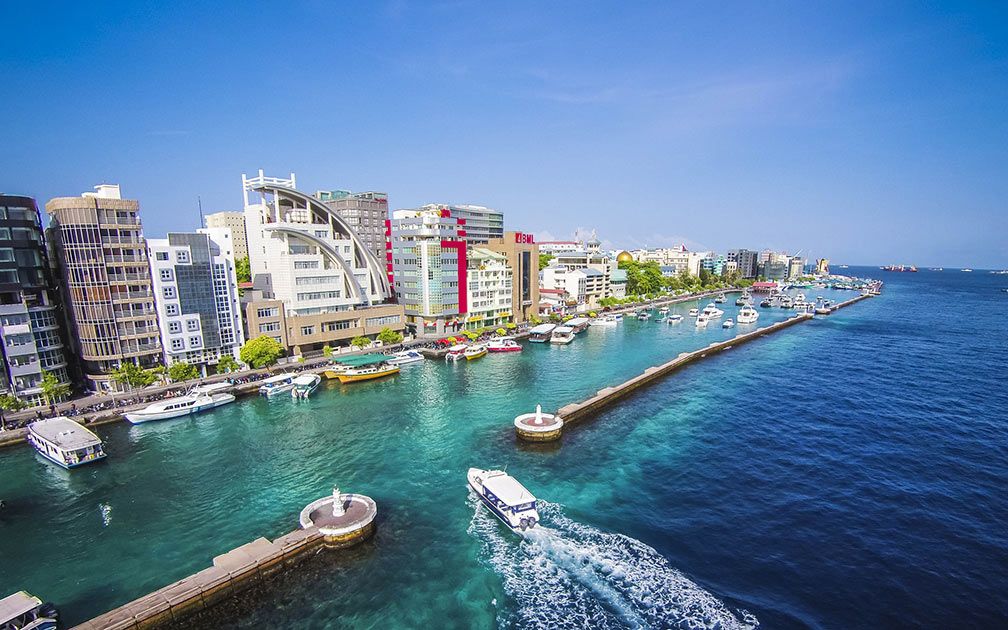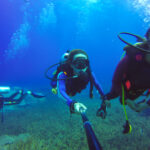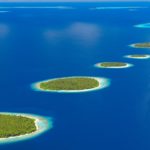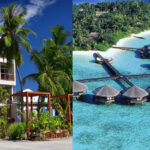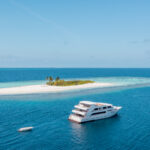When you think of the Maldives, images of luxury resorts on idyllic islands likely come to mind, and the beating heart of this nation is its bustling capital, Male’. This vibrant city has over a two hundred thousand inhabitants, making it one of the densest cities in the world.
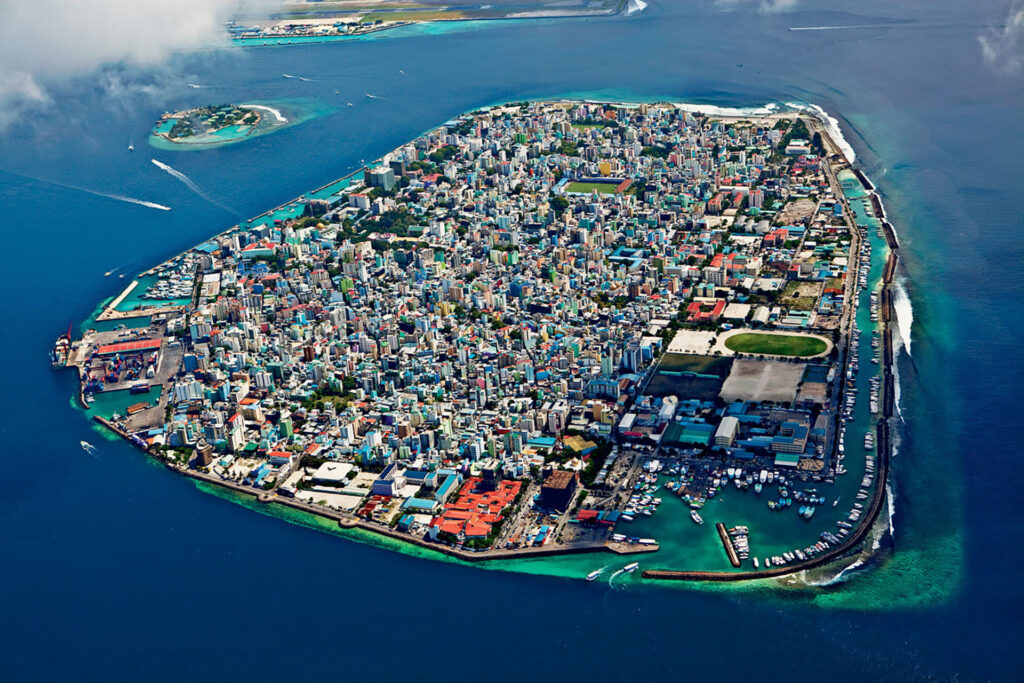
A city of rich history, Male’ has been the center of power since the 12th century. Its transformation from a fishing village to a bustling city tells the story of a nation balancing tradition and modernity.
While the Maldives’ resorts offer an unrivaled luxury experience, Male’ provides an authentic insight into Maldivian culture. From its vibrant markets to historic mosques, this city should not be overlooked.
How can I get to Male’
Reaching Maldives from other parts of the world is a journey in itself, full of anticipation and stunning views. To get to Malé, the capital city of Maldives, you have several options depending on your starting location. Reaching the country involves air travel. Here are some ways you can reach Malé:
International Flights
Malé is served by Velana International Airport, which is the main gateway to the Maldives. Various international airlines operate regular flights to and from this airport, connecting Malé to numerous major cities around the world. You can check with airlines for available flights and book your tickets accordingly. Read my detailed article on how can I get to the Maldives and how can I get around.
From Airport to Male’
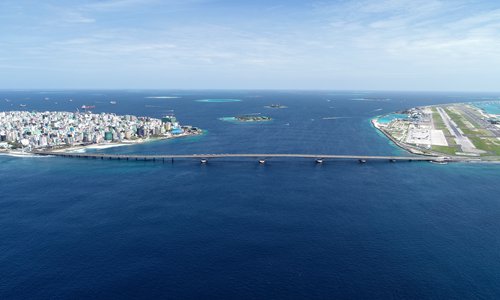
Once you arrive at Velana International Airport, there are multiple convenient transportation options available to reach Malé, the capital city of Maldives:
- Taxi: The most common and convenient way to reach Malé from the airport is by taxi. Taxis are readily available outside the airport terminal, and you can easily spot the designated taxi area. The journey to Malé takes approximately 10-15 minutes, depending on the traffic conditions. There is a bridge connecting the airport island (Hulhule) to Malé, making the taxi ride a quick and straightforward option.
- Speedboat: Another popular option is to take a speedboat to reach Malé. The speedboat service operates 24/7, allowing you to travel to the capital at any time of the day or night. The speedboat terminal is located near the airport, and you can easily find it by following the signs or asking the airport staff for directions. The speedboat journey typically takes around 20-25 minutes, offering you a scenic ride across the sparkling waters of the Indian Ocean.
- Local Ferry Service: If you’re looking for a more budget-friendly option, you can consider taking the local ferry service. The ferry departs from the airport island and makes stops at different islands before reaching Malé. This option allows you to experience the local way of travel and offers a chance to interact with the friendly Maldivian community. The ferry schedule is usually fixed and operates during specific hours, so it’s advisable to check the timetable in advance and plan your journey accordingly.
From Resorts to Male’
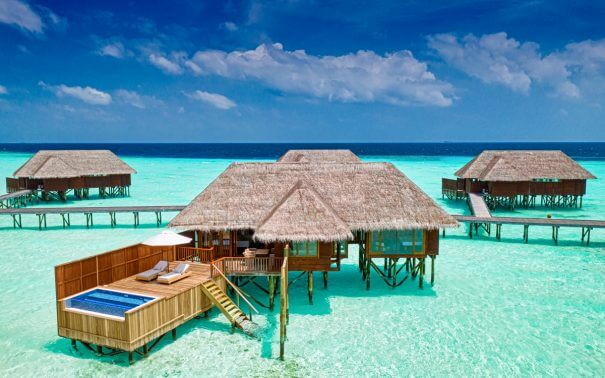
If you have already booked a resort in Maldives, many of them offer transportation services to and from Malé. Resorts often arrange day trips to Malé for their guests to explore the capital city. You can inquire with your resort about the availability and schedules of these transfers.
From Guesthouse Islands to Male’
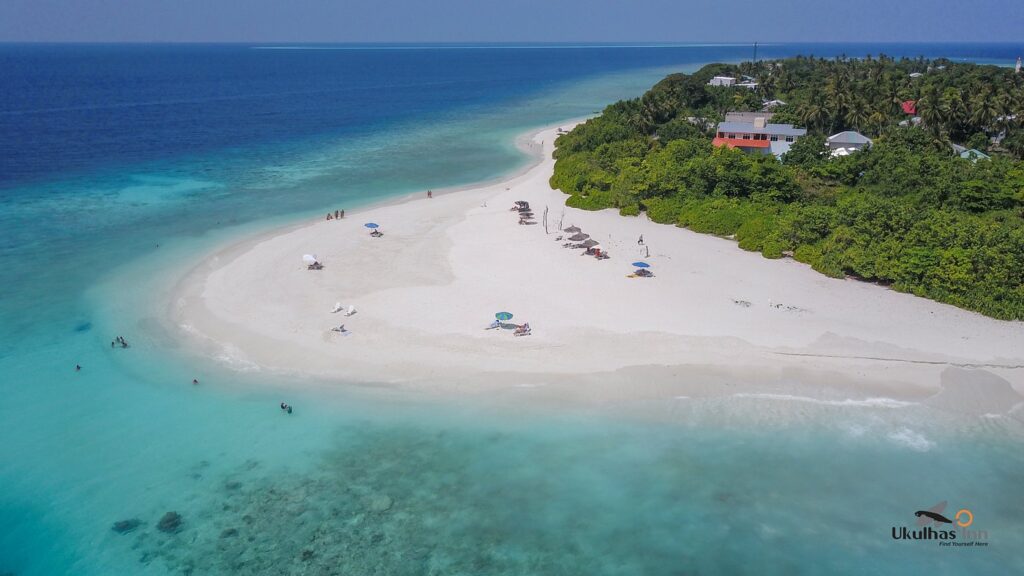
If you are staying in a guesthouse on a nearby island and depending on the distance and location of your starting point, you may have the option of taking a speedboat or ferry to Malé.
This is more common for travelers who are already in the Maldives and wish to explore other islands before heading to the capital. These transportation services are available from various islands, and you can inquire locally about the schedules and availability.
Navigating the Streets of Male’
Compact yet full of life, navigating Male’ can be an adventure all on its own. Despite its small size, the city is packed with fascinating sights.
Walking is perhaps the best way to explore Male’, allowing you to soak up the local atmosphere at your own pace. Most attractions are within walking distance of each other. For longer distances, taxis are readily available, and there is a public bus service connecting various parts of the city. The fares are reasonable, and the services are reliable.
If you have more time, consider taking a ferry to one of the nearby island “Villigili” which takes about 10 minutes by ferry. The island offers a glimpse of life outside the capital.
Unveiling the Charms of Male’
The unique character of Male’ comes alive when you immerse yourself in its diverse attractions. From historical landmarks to bustling markets, the city holds an mix of experiences that mirror its unique blend of tradition and modernity. Embark on this journey through Male’, where every corner uncovers a new chapter of the Maldivian narrative.
act is a silent testament to the country’s rich heritage, inviting you to dive deep into its historical saga.
A. The Grand Friday Mosque

You can start your visit to Male’ with a visit to Grand Friday Mosque, also known as Masjid-al-Sultan Muhammad Thakurufaanu Al Auzam.
This architectural gem is the largest mosque in the Maldives and a prominent symbol of the country’s Islamic faith. It can accommodate over 5,000 worshippers within its grand, whitewashed walls.
The mosque’s design is a beautiful fusion of traditional Islamic architecture and contemporary aesthetics, dominated by a majestic, golden dome. Inside, the mosque’s vast prayer hall is adorned with intricate woodwork and Arabic calligraphy, with verses from the Quran embellishing its walls. A sense of serenity permeates the space, allowing visitors to absorb the spiritual ambiance.
B. Sultan Park and the National Museum
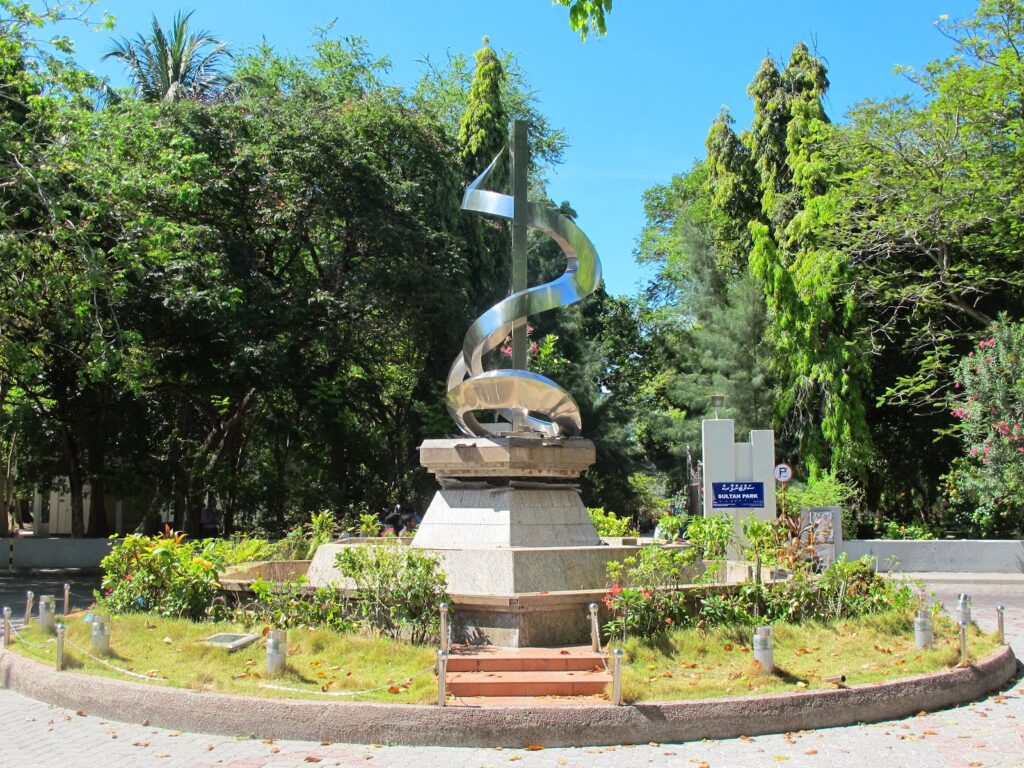
Right next to Moaque is Sultan Park, which offers a refreshing respite for visitors with its lush greenery and tranquil ambiance. A stroll through this park provides a pleasant escape from the city’s crowded streets.
Within the confines of Sultan Park, the National Museum holds the keys to the city’s past. Originally a palace, this three-storied structure houses a captivating collection of historical artifacts. From ancient thrones and royal sunshades to centuries-old weapons and religious relics, the museum narrates the Maldives’ intriguing history. Exploring its halls, you will come across intricately carved Arabic and Thaana-engraved pieces of wood, stone, and coral from the Hukuru Miskiy and other ancient temples. Each artif
C. Old Friday Mosque and Central Tomb
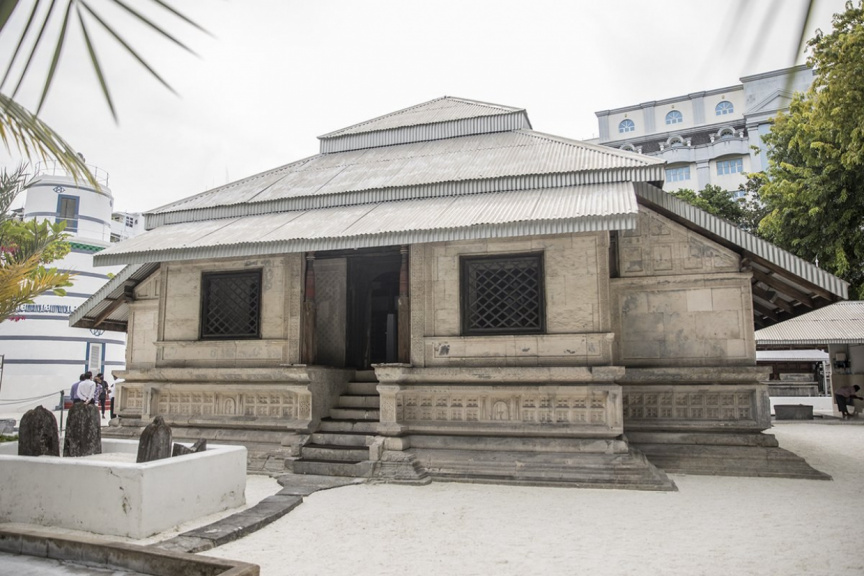
The next stop is the Old Friday Mosque, also known as Hukuru Miskiy. This is an important historical and cultural landmark in Malé, the capital city of the Maldives.
Constructed in 1658, this grand edifice is the oldest mosque in the country and is a testament to Maldivian craftsmanship, architecture, and Islamic heritage. The mosque’s intricate wood carvings and beautiful coral stone structure are decorated with Arabic calligraphy, featuring traditional Maldivian designs. Its unique minaret and the ancient cemetery adjoining it, with tombstones made of coral stone, add to the ethereal atmosphere of this site. Recognized by UNESCO as a cultural heritage site, the Old Friday Mosque encapsulates the rich historical and spiritual journey of the Maldivian people.
Infront of Old Friday Mosque is Medhu Ziyaaraiy, an important historical shrine of the Maldives. Translated as ‘Central Tomb’, Medhu Ziyaaraiy is the final resting place of Moroccan scholar, Abul Barakat Yousef Al-Barbari, who is traditionally believed to have introduced Islam to the Maldives in 1153 AD. This shrine is a testament to the country’s deep Islamic heritage and is a site of great cultural and spiritual significance. The tomb itself is a humble, yet dignified structure, showcasing the respect and honor the Maldivians have for their historical past. Tomb is next to ‘Muliaage’, the Official residence of the President of the Maldives.
D. The Maldives Fish Market

Immerse yourself in the heart of Male’s daily life at the bustling Maldives Fish Market. A testament to the Maldives’ deep connection with the sea, this market is a sensory explosion. The air fills with the fresh scent of the ocean, mixed with the lively shouts of fishermen hawking their daily catch.
From the break of dawn, local fishermen offload their catch of tuna, grouper, and other marine delicacies. Observing this traditional daily routine is a unique and unmissable experience. It’s not just a market; it’s the lifeblood of the city, pulsating with energy and local flavor. Don’t miss the chance to witness the fishmongers’ precise and practiced skills as they swiftly clean and fillet the fish, ready for the eager customers.
E. The Artificial Beach
While the Maldives is famous for its pristine white sandy beaches, Male’ itself does not have a natural beach. However, the city has creatively addressed this with the Artificial Beach, a human-made sandy spot popular among locals and tourists alike.
Located on the eastern seafront, this sandy stretch provides a recreational space for swimming, water sports, and relaxing by the water. Throughout the day, it’s a hub of activity, with children splashing in the shallows, teenagers engaging in beach volleyball, and families enjoying picnics. As evening descends, the beach transforms into a romantic spot, with the setting sun casting a magical glow over the cityscape.
Shopping: Uncover Male’s Hidden Treasures
Shopping in Male’ is a unique cultural experience, offering a chance to bring home a piece of the Maldives. Whether it’s the intricate handicrafts, fresh local produce, or high fashion, Male’s markets and boutiques have something to cater to all tastes and budgets. Let’s explore the city’s vibrant shopping scene.
A. Local markets and what to buy
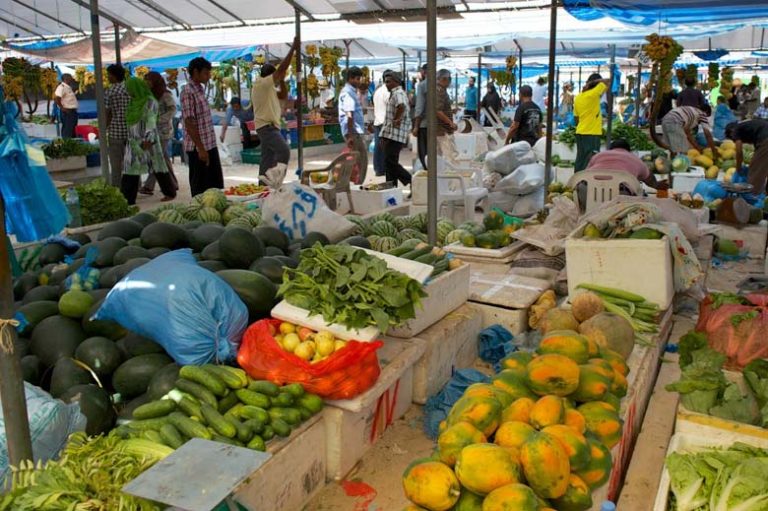
Male’ Local Market, located on the northern waterfront, is a paradise for those who appreciate authentic local produce.
This bustling market is filled with stalls offering a vibrant array of fresh fruits and vegetables, many of which are grown on the nearby islands. Try the Maldivian coconuts, bananas, and the fresh “rihaakuru,” a local fish paste that’s a staple in Maldivian cooking.
B. Best shops for souvenirs
For souvenirs that encapsulate Maldivian culture, visit Island Bazaar. This chic boutique showcases a carefully curated selection of local crafts, handmade jewelry, home decor, and organic beauty products. You’ll find beautiful Maldivian mats, traditional “roanu” lacquerware, and even locally produced coconut oil.
Another excellent place for souvenirs is the STO Trade Centre. Here, you can find a variety of local products, from Maldivian spices and tea to traditional garments. Read my article on souvenirs from the Maldives.
C. Majeedhee Magu – the main shopping street
Majeedhee Magu, the city’s main shopping street, stretches from east to west, offering a bustling mix of shops. This vibrant thoroughfare has stores selling everything from electronics and designer fashion to local handicrafts and homeware.
Whether you’re looking for the latest gadgets, trendy clothing, or unique Maldivian souvenirs, you’ll find it here. The street comes alive at night, with shops staying open late, offering a pleasant shopping experience amidst the city’s illuminated skyline.
A Culinary Journey Through Male’
Food in Male’, the capital city of the Maldives, is a vibrant mix of local flavors and international cuisines, offering a culinary journey you won’t forget. From humble food stalls tucked away in narrow streets to high-end restaurants with breathtaking views, the city’s food scene is as diverse as it is delicious.
A. Local cuisine and must-try dishes
Maldivian cuisine is deeply rooted in the country’s coastal location and tropical bounty, making use of fresh seafood, coconuts, and aromatic spices. When in Male’, be sure to indulge in these must-try dishes:
- Mas Huni: Start your day with a traditional Maldivian breakfast by trying Mas Huni. This beloved dish features finely shredded smoked fish (often tuna) mixed with grated coconut, onions, and a blend of spices. It is usually enjoyed with roshi (unleavened bread) or chapati, creating a delightful combination of flavors and textures.
- Garudhiya: A staple in Maldivian cuisine, Garudhiya is a flavorful fish broth made by boiling freshly caught fish, typically tuna, with local herbs and spices. The resulting broth is aromatic and rich, showcasing the essence of the ocean. It is served alongside steamed rice and often accompanied by lime and chili for an added kick.
B. Popular restaurants and cafes in Male’
When it comes to dining out in Male’, the city offers a plethora of options to suit every palate and preference. Here are a few popular establishments that are worth a visit:
- The SeaHouse: Located by the waterfront, The SeaHouse offers not only a delectable dining experience but also stunning views of the Indian Ocean. This restaurant specializes in both Maldivian and international cuisines, featuring an array of seafood dishes made with the freshest catch of the day. Whether you choose to savor grilled fish, seafood curries, or international favorites, The SeaHouse promises an unforgettable culinary experience.
- Belle Amie Bistro: Known for its cozy atmosphere and attentive service, Belle Amie Bistro is a charming establishment popular among both locals and tourists. The menu at Belle Amie Bistro showcases a fusion of international flavors, offering a diverse range of dishes to cater to various tastes. From Italian pastas and pizzas to local specialties like mas huni and curry, the bistro ensures a delightful culinary adventure for its patrons.
- Symphony Solo: This restaurant is located near the Maldives National Museum and is known for its extensive menu offering Maldivian, Indian, and other Asian cuisines. It’s especially popular among locals.
- Shell Beans: A popular café in Malé offering a wide range of coffees, sandwiches, pastries, and other Western-style café food. It’s a great spot to take a break from exploring the city.
- Jazz Café & Restaurant: This place serves a variety of dishes from pasta to grilled items, and is loved by the locals for its cozy atmosphere. There are also live music performances, making it an enjoyable place for a meal or a coffee.
- The Manhattan Fish Market: Offering a wide selection of seafood dishes prepared in various styles, this place is for those craving for a seafood feast. The restaurant is located in a central area, making it easy to access.
- Aioli Restaurant: This restaurant offers a varied menu with a particular emphasis on Western and Mediterranean cuisine, including pasta, pizzas, and seafood dishes.
- Oxygen Café: Located near the Maldivian President’s official residence, the Muleeaage, this café serves good food at reasonable prices. It’s especially popular for its juices and smoothies.
C. Local food culture in Male’
No culinary journey through Male’ is complete without exploring local food culture that thrives in the city. As you wander through the bustling streets, you’ll encounter numerous food stalls (“Hotaa”) serving an array of local snacks known as “hedhikaa.” Here are a few street food highlights to tantalize your taste buds:
- Bajiya: A popular snack in the Maldives, Bajiya is a deep-fried pastry filled with a savory mixture of fish or vegetables, combined with spices and onions. These crispy and flavorful treats are perfect for a quick bite while exploring the city.
- Gulha: Another street food favorite, Gulha are small, round fish balls made from minced tuna mixed with coconut, onion, and a blend of spices. These bite-sized delights are deep-fried until golden brown, resulting in a crispy exterior and a succulent, flavorful interior. They are often served with a side of spicy chili sauce, adding an extra kick to each mouthful.
A Safe and Respectful Visit to Male’
While Male’ is generally a safe city for tourists, there are a few considerations to keep in mind to ensure a seamless experience. Being aware of local customs and safety guidelines can enhance your visit significantly.
Maldivians are friendly and hospitable, but it’s important to respect their customs. Modest dress is required in public places, and during Ramadan, eating in public is discouraged.
While crime is relatively low in Male’, it’s always wise to keep an eye on your belongings, especially in crowded areas. Also, remember to stay hydrated and protect yourself from the sun.
Key phrases in Dhivehi, the local language
While English is widely spoken, learning a few phrases in Dhivehi can be a fun way to interact with locals.
- Hello – Assalaamu alaikum
- Yes – Aan
- No – Noon
- Thank you – Shukuriyaa
- You’re welcome – Maruhabaa
- Excuse me – Ma-aaf kurey
- I’m sorry – Ma-aafu kurey
Recap of what to expect in Male’
From its lively markets and historical landmarks to its eclectic food scene, Male’ promises a day packed with memorable experiences. It’s a city where tradition meets modernity, offering a rich tapestry of sights, sounds, and tastes.
Have you been to Male’? We’d love to hear your stories and tips. Every traveler brings back unique insights and memories, and your experiences could help other readers plan their perfect day in Male’.
Frequently Asked Questions About Male’
Q1: Do I need a visa to visit the Maldives?
All tourists receive a free 30-day visa on arrival. However, it’s always a good idea to check the latest information with your nearest Maldivian embassy or consulate.
Q2: Is Male’ a safe city to visit?
Yes, Male’ is generally considered safe for tourists. However, like anywhere, it’s important to stay vigilant and follow local guidelines.
Q3: Can I use US dollars in Male’?
While the local currency is the Maldivian Rufiyaa, US dollars are widely accepted in Male’ and throughout the Maldives.
Q4: How much time do I need to explore Male’?
Given its small size, Male’ can be comfortably explored in a day. However, if you want to delve deeper into its culture and history, consider extending your visit.

